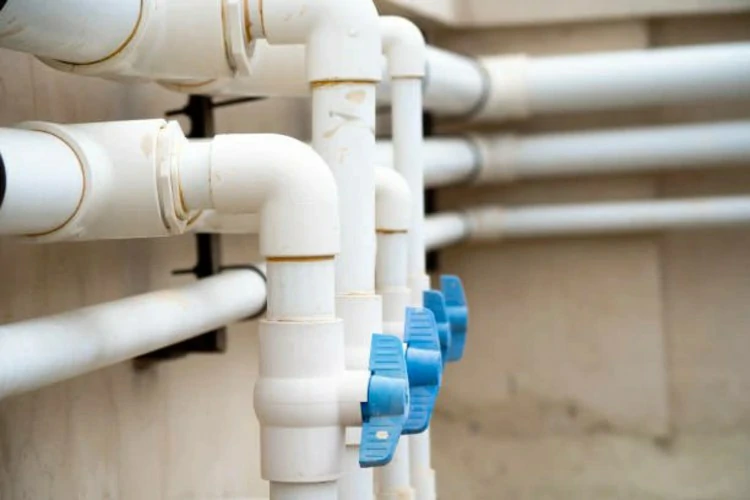Introduction
As a thermoplastic, CPVC pipe has been widely used in the field of pipe and has made remarkable achievements. CPVC, derived from chlorinated polyvinyl chloride resin, exhibits exceptional physical properties, ease of installation, chemical resistance, antibacterial qualities, flame retardancy, and environmental sustainability due to its unique molecular structure. CPVC outperforms alternatives like PPR piping with its superior tensile and bending strength, making it an excellent choice for industrial piping systems. This article will explore CPVC’s features, benefits, and potential drawbacks, shedding light on its versatile applications and influence across sectors.
What is a CPVC pipes
CPVC is a thermoplastic further chlorinated from polyvinyl chloride resin. That means it has two carbons attached, two hydrogens, and two chlorines attached to this two-carbon unit. This molecule combines with other molecules to form a CPVC polymer chain.
Characteristics of CPVC pipes – compared to PPR pipes
Physical properties: Compared to PPR, CPVC has a 60% increase in tensile strength and nearly a tripling in bending strength, making it a stronger and more durable piping material. Its strength allows CPVC to withstand greater pressure, resulting in the use of smaller pipes at the same flow rate.
Installation: CPVC uses a simple solvent-cement welding process, which has the advantage of easier and more efficient installation compared to PPR systems that use hot melt welding connections.
Chlorine resistance: CPVC can prevent the impact of hypochlorous acid in drinking water on pipeline materials through chlorination treatment and improve the service life of the pipeline system. In contrast, PPR is susceptible to hypochlorous acid exposure, causing oxidative stress cracking and erosion of pipe walls.
Inhibition of bacterial growth: The smooth surface of CPVC pipes and the lack of plasticizers hinder the growth of microorganisms and have superior antibacterial properties compared to other pipe materials, especially PPR.
Fire resistance: CPVC pipes do not support combustion and require 60% oxygen in the atmosphere to maintain the flame. Its carbonized layer acts as an insulator at high temperatures, reducing the risk of fire. In contrast, PPR has a higher flammability with a limiting oxygen index of 18, which generates more heat when burned, increasing the risk of fire.
Environmentally friendly and sustainable: CPVC has a lower oil content and requires less energy during manufacturing. At the end of its useful life, CPVC can be recycled and reused, contributing to environmental protection and sustainable development.
Summary of the advantages of CPVC pipes
In the field of pipelines, the wide application of CPVC pipelines stems from its many advantages. The adoption of CPVC pipes and fittings effectively solves internal and external corrosion problems, reducing the risk of process leakage, flow limitation, and premature pipe failure. CPVC piping is easy to install and requires little additional maintenance for proper installation. In addition, due to the nature of CPVC itself, it is able to prevent penetration even in the harshest soil and air conditions, so no external pipe coating is required. The smooth inner surface of CPVC industrial pipes resists scaling and buildup, minimizing frictional pressure losses in fluid flow. CPVC is not only safer than metal in terms of installation, but also safer during use.
CPVC pipelines offer a reliable fluid transfer solution in various industries, enhancing reliability and simplifying maintenance and operation. Their superior performance makes them a top choice for numerous engineering projects, driving significant improvements and convenience in the pipeline industry.
Disadvantages of CPVC pipes
They are excellent at resisting chemical attacks. CPVC pipe, also known as hard PVC, is a kind of plasticized PVC. In the field of cold water piping, CPVC pipes and fittings are preferred. These pipes are very light and easy to handle. They exhibit excellent mechanical properties, long-term durability, and excellent resistance to chemicals and UV rays. In the CPVC pressure pipeline, solvent cement connection technology is the most common.
Conclusion
CPVC pipe is a thermoplastic made of chlorinated polyvinyl chloride resin, which is widely used in the pipeline industry. Compared to PPR pipes, CPVC has higher tensile and bending strength, making it a more robust, durable choice. Users prefer CPVC pipes for their ease of installation and outstanding chemical resistance, especially against chlorine, which contributes to their popularity in cold water applications. Their antibacterial properties, non-combustible nature, and minimal environmental impact further enhance their suitability for industrial piping systems. However, CPVC pipelines may have limitations in certain scenarios despite their overall performance.
Contact
IFANPLUS is a professional product line launched by IFAN, which mainly covers plastic pipes, fittings and various types of valves. We have German and American standard PPR,PVC products, we produce high standard PPR and PVC pipes, to ensure the quality and reliability of products. IFANPLUS valve products include a wide range of valves, from PPR valves to other diverse copper valves to meet your specific requirements. No matter what kind of products you need, IFANPLUS will be your reliable partner. Below is our contact information.
We will reply your email or fax within 24 hours.
You can call us at any time if there is any question on our production.
For more information,pls visit our webside https://www.ifanplus.com/
Pls Mailto: [email protected]






